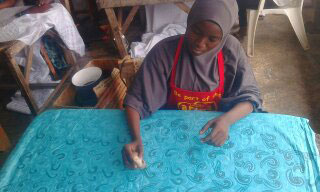Author: Mariam Oladepo-Ajagbe
Surface Designer| Digital & Traditional
@designs_n_fibers | Linkedin
Article
In a world where tradition and technology often seem at odds, how can the textile industry evolve without losing its cultural roots? What usefulness is digital technology to the textile industry? This article discusses the implications of blending digital and traditional techniques, bringing insights from the research “Exploring the Synergy of Traditional Textile Techniques and Digital Technology in Contemporary Clothing and Textile Design”. It further explores how combining traditional and digital textile techniques can revolutionize contemporary textile design and reviews the expert interviews from the research as mentioned earlier.

The textile industry has a rich history that spans millennia and is deeply intertwined with the cultural, social, and economic fabric of societies worldwide. Traditional textile techniques such as weaving, embroidery, dyeing, and printing have been passed down through generations, preserving cultural heritage while also adapting to the changing needs of the times. As we entered the 21st century, the textile industry began to witness a significant transformation with the advent of digital technology. The rise of Computer-Aided Design (CAD) systems, digital printing, and other technological advancements revolutionized the way textiles are designed, produced, and consumed. These tools introduced a new level of precision, efficiency, and creative potential, enabling designers to experiment with patterns and colors in ways that were previously unimaginable. While digital technology has democratized textile design, making it more accessible to a broader audience and allowing for mass customization, it has also provided ways for designers to create unique designs and explore their creativity.
Integration of Digital and Traditional Techniques.

The manual loom employed in traditional weaving has given way to digital jacquard looms, which enable the creation of complex designs through computer-aided design (CAD) software, which is then converted into weaving instructions. The development of 3D weaving technology is another method that makes it possible to produce textiles with intricate three-dimensional structures and several layers. This is especially important for specialized textile applications, such as automotive, aerospace, and medical sectors, where multi-layered materials can provide more capability. Additionally, advancements in the weaving of conductive materials into textiles have produced smart fabrics with the ability to control temperature, monitor health, and provide sensory feedback. Waterless dying processes recycled and bio-based fibers, robotic and automated weaving, and many more.

In the printing field, the advent of technology brought a colorful life and creativity to traditional printing techniques. Unlike the time-consuming traditional printing, advances in digital textile printing have led to machines capable of printing at much higher speeds while maintaining high-resolution output. Among many other innovations are Direct-to-Fabric printing (DTF) where designs are printed directly onto textiles without the need for transfer paper or screens. Furthermore, the integration of 3D printing technology with textiles allows for the creation of raised, three-dimensional designs on fabric giving way to broader opportunities. The advanced ink-jet printing etc. all of which have sparked creativity and yielded unique textile art and designs.

It is important to note that digital technology does not need to eliminate traditional craftsmanship but will rather aid and enhance it. An example is the use of the Hybrid Printing technique, which involves combining traditional textile printing methods with 3D printing. This has led to the creation of hybrid textiles that offer unique aesthetic and functional properties.
Drawing insights from the research survey, experts in the clothing and textile field had emphasized positive reception towards the integration of digital technology with traditional techniques. It was noted that there are challenges in doing this but it never counter-measured the great benefit derived from technological advancement. Overall, the survey highlights the resilience and adaptability of clothing and textile artists in embracing technological advancements while preserving the rich heritage of traditional techniques.